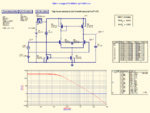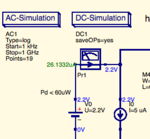isaac12345
Member level 2
Hi all!
Been trying to design a differential amplifier with the following specifications(in cadence virtuoso) but been unsuccessful again and again. Given up! Can anyone give it a try and explain(with a schematic?). Would much appreciate it
Specs -
Av =>40db
Pd<100uW
Slew Rate=>20v/usec
CMRR=>50db
ICMR=0.8 to 3.0v
Gain Bandwidth product = 50MHz
Vout swing =0.7 to 1.5v
Assume load capacitance = 1pF, Vdd=2.2v, unCox=300u and upcox=50u
Been trying to design a differential amplifier with the following specifications(in cadence virtuoso) but been unsuccessful again and again. Given up! Can anyone give it a try and explain(with a schematic?). Would much appreciate it
Specs -
Av =>40db
Pd<100uW
Slew Rate=>20v/usec
CMRR=>50db
ICMR=0.8 to 3.0v
Gain Bandwidth product = 50MHz
Vout swing =0.7 to 1.5v
Assume load capacitance = 1pF, Vdd=2.2v, unCox=300u and upcox=50u

